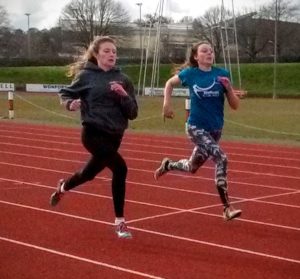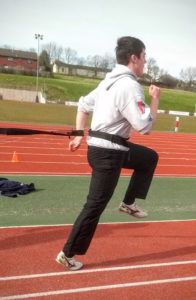How to develop speed: Gary Winckler
Tenets of speed development
“The hamstrings transfer force from the motor of the butt to the wheels of the foot.” Athletics coach Gary Winckler delivered an excellent overview on what he thinks is important on speed development at GAIN. A lot of the work is similar to what Frans Bosch did a couple of years ago, and he mentioned Bosch’s work a lot.
Training muscles for speed
Before doing speed assistance exercises in the gym or on the track, it is important to determine how the muscles work. There is no point doing lying down leg curls, or Nordic curls to “strengthen the hamstrings” if they are not used that way in running.
The big gluteal muscles (The Big House) have a mostly parallel muscle fibre structure, and work concentrically. They are also known as “stupid muscles” because any exercise used to work them will transfer well to use in sport.
The hamstrings are a complicated bi-articluar muscle with a pennate structure. This means they are better suited to reactive forces; not suitable for rapid shortening.
Reactive forces: the muscles set up a system to allow tendons to do what they are designed to do. In practice we are looking for a very rapid transition from a closed chain to an open chain at the moment of toe off.
Posture is again important here: poor posture will result in either too much deceleration due to poor foot placement, or the hamstrings unable to utilise tendon elasticity properly due to poor pelvic placement.
The importance of the foot / ankle.
Instead of being passengers in the running cycle, the foot and ankle are key parts of the process. Winckler uses his ears to “Listen to it when they run”. He can hear the ankle reactivity as there is less contact time.
As an experienced track coach he uses awareness and sensory exercises to help his athletes develop the right patterns. I made the point that being less experienced, I have to use drills to analyse parts of the process. I can’t see what is happening at full speed. That will come with experience.
It is important to keep a “neutral and active foot”. (Those athletes doing speed development work with me over the last 2 years will know about this). Winckler then took some of us through a series of his basic drills to highlight the importance of foot reactivity.
Again, I felt better by doing something and “having a go”; I am not afraid to make mistakes in the hope of learning something.
I asked a question about arms, and Winckler expressed his thoughts that “the arms are a symptom of what is going wrong elsewhere rather than the cause“. This was a good tip for me.
“Work on top speed, not just acceleration, otherwise what are you accelerating to?”
Co-ordination is the ultimate goal
When deciding how to enhance the speed of an athlete, either in the gym or on the track, it is the co-ordination of the body that is most important.
This can be expressed as follows:
- Strength is co-ordination training under resistance
- Endurance is co -ordination training under prolonged or event specific time restraints
- Speed is the expression of co -ordination.
Strength, speed and mobility are interdependent qualities.
Weightlifting for speed development
In the gym we did some more exercises, but this time with external load, to enhance speed. This included hang clean variations with 1 foot behind the body, toe on the floor, then hopping up onto a step after the catch. We progressed through levels of difficulty on this drill, and this certainly challenged a few of the attendees.
Another drill was a lateral step down and up onto a higher box with the bar on our backs. The idea was to get a reactive foot action and toe up onto the higher box. This was very tricky, and Kelvin Giles got “stuck into me” until I had some semblance of competency.
Medicine balls
We looked at some horizontal medicine ball work lying on your back and throwing as well as step ups on to the step with a throw and extension at the end: this helps acceleration all the way through.
A lot of talk about abdominal work misses the point about doing it in the same environment as the sport. Winckler uses overhead bar runs, or walking with a partner doing resistive band work behind to work the hip\ abdomen area.
We also did a drill holding onto the band horizontally as it was attached to a pillar and our partner was moving it so we had to try and stabilise.
The whole session emphasised the importance of co -ordination (or lack of it) under load.
Summary
Winckler was an example of a “sharp” coach. He is very softly spoken, but he was right on with his observations. It was great to hear some similar messages to Bosch, but from a different coaching aspect. His work in the gym was excellent. I think we would have benefited from being on the track with Gary and seeing how he coaches hurdlers, and what he sees.
Next: Power, research and planning



[…] will also be Gary Winckler’s last coaching session before he retires. I will be picking his brain for speed development […]
[…] Next: How to develop speed […]
[…] review of Track coach Gary Winkler’s seminar on speed training describes the importance of making every […]
[…] Gary Winckler had previously spoken to me about the upper body being an indicator of what was going on below. […]
[…] friend James Marshall has put together some great notes on presentations by Winckler at GAIN: how to develop speed and training dos and […]